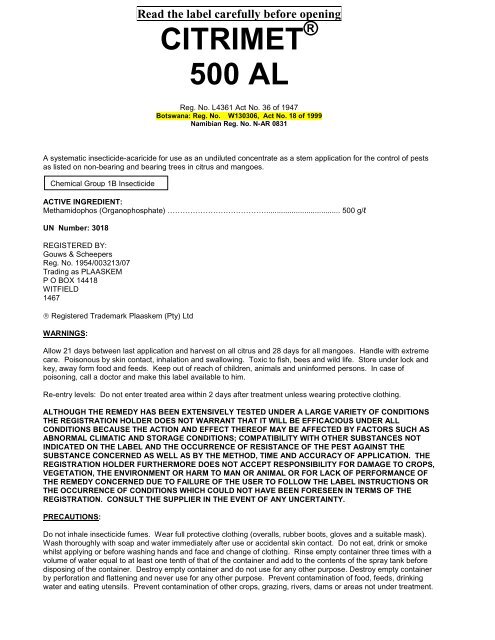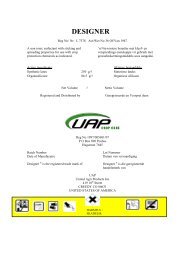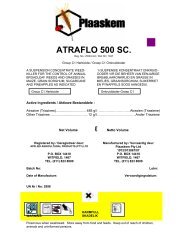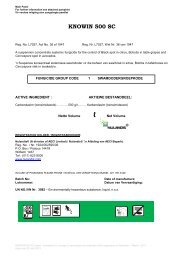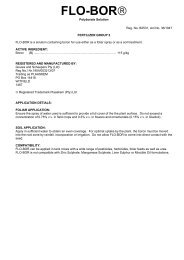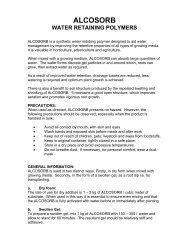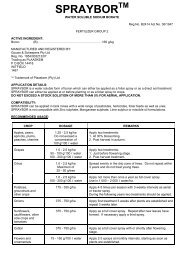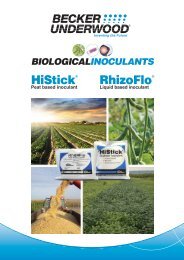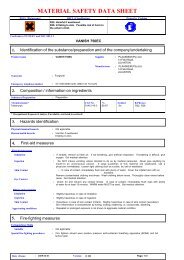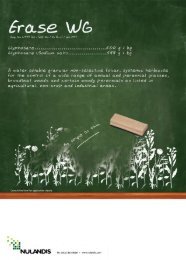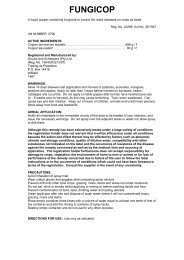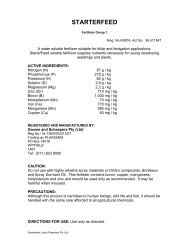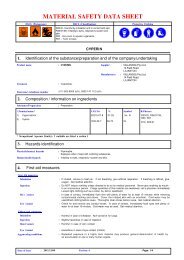CITRIMET 500 AL - Nulandis
CITRIMET 500 AL - Nulandis
CITRIMET 500 AL - Nulandis
Create successful ePaper yourself
Turn your PDF publications into a flip-book with our unique Google optimized e-Paper software.
Read the label carefully before opening<br />
<strong>CITRIMET</strong> ®<br />
<strong>500</strong> <strong>AL</strong><br />
Reg. No. L4361 Act No. 36 of 1947<br />
Botswana: Reg. No. W130306, Act No. 18 of 1999<br />
Namibian Reg. No. N-AR 0831<br />
A systematic insecticide-acaricide for use as an undiluted concentrate as a stem application for the control of pests<br />
as listed on non-bearing and bearing trees in citrus and mangoes.<br />
Chemical Group 1B Insecticide<br />
ACTIVE INGREDIENT:<br />
Methamidophos (Organophosphate) …………………………………................................... <strong>500</strong> g/ℓ<br />
UN Number: 3018<br />
REGISTERED BY:<br />
Gouws & Scheepers<br />
Reg. No. 1954/003213/07<br />
Trading as PLAASKEM<br />
P O BOX 14418<br />
WITFIELD<br />
1467<br />
® Registered Trademark Plaaskem (Pty) Ltd<br />
WARNINGS:<br />
Allow 21 days between last application and harvest on all citrus and 28 days for all mangoes. Handle with extreme<br />
care. Poisonous by skin contact, inhalation and swallowing. Toxic to fish, bees and wild life. Store under lock and<br />
key, away form food and feeds. Keep out of reach of children, animals and uninformed persons. In case of<br />
poisoning, call a doctor and make this label available to him.<br />
Re-entry levels: Do not enter treated area within 2 days after treatment unless wearing protective clothing.<br />
<strong>AL</strong>THOUGH THE REMEDY HAS BEEN EXTENSIVELY TESTED UNDER A LARGE VARIETY OF CONDITIONS<br />
THE REGISTRATION HOLDER DOES NOT WARRANT THAT IT WILL BE EFFICACIOUS UNDER <strong>AL</strong>L<br />
CONDITIONS BECAUSE THE ACTION AND EFFECT THEREOF MAY BE AFFECTED BY FACTORS SUCH AS<br />
ABNORM<strong>AL</strong> CLIMATIC AND STORAGE CONDITIONS; COMPATIBILITY WITH OTHER SUBSTANCES NOT<br />
INDICATED ON THE LABEL AND THE OCCURRENCE OF RESISTANCE OF THE PEST AGAINST THE<br />
SUBSTANCE CONCERNED AS WELL AS BY THE METHOD, TIME AND ACCURACY OF APPLICATION. THE<br />
REGISTRATION HOLDER FURTHERMORE DOES NOT ACCEPT RESPONSIBILITY FOR DAMAGE TO CROPS,<br />
VEGETATION, THE ENVIRONMENT OR HARM TO MAN OR ANIM<strong>AL</strong> OR FOR LACK OF PERFORMANCE OF<br />
THE REMEDY CONCERNED DUE TO FAILURE OF THE USER TO FOLLOW THE LABEL INSTRUCTIONS OR<br />
THE OCCURRENCE OF CONDITIONS WHICH COULD NOT HAVE BEEN FORESEEN IN TERMS OF THE<br />
REGISTRATION. CONSULT THE SUPPLIER IN THE EVENT OF ANY UNCERTAINTY.<br />
PRECAUTIONS:<br />
Do not inhale insecticide fumes. Wear full protective clothing (overalls, rubber boots, gloves and a suitable mask).<br />
Wash thoroughly with soap and water immediately after use or accidental skin contact. Do not eat, drink or smoke<br />
whilst applying or before washing hands and face and change of clothing. Rinse empty container three times with a<br />
volume of water equal to at least one tenth of that of the container and add to the contents of the spray tank before<br />
disposing of the container. Destroy empty container and do not use for any other purpose. Destroy empty container<br />
by perforation and flattening and never use for any other purpose. Prevent contamination of food, feeds, drinking<br />
water and eating utensils. Prevent contamination of other crops, grazing, rivers, dams or areas not under treatment.
Clean applicator after use with FLUSHSOL* and make sure that wash water does not contaminate grazing or<br />
drinking water.<br />
SYMPTOMS OF HUMAN POISONING:<br />
Headache, fatigue, faintness, giddiness, excessive sweating, nausea, abdominal pains, vomiting, diarrhoea,<br />
tightness of the chest, anxiety, blurred vision, muscle twitching (beginning in the eyelids and tongue), small pupils,<br />
respiratory distress, convulsions and coma.<br />
FIRST AID TREATMENT:<br />
Remove patient from source of poisoning to a cool and well-ventilated area and keep him quiet and reassured.<br />
Remove contaminated clothing and rinse contaminated body area thoroughly with plenty of soap and cold water. Do<br />
not rub the skin. Flush contamination out of eyes with clean water for at least 15 minutes. If concentrate has been<br />
swallowed, firstly give copious quantities of either beaten egg white, starch solution or Milk of Magnesia before<br />
inducing vomiting by tickling back part of the throat. Repeat until vomit is clear and free from the smell of poison.<br />
Take the patient immediately to the nearest physician. Administer artificial respiration or closed chest cardiac<br />
massage if necessary. Do not apply direct mouth–to-mouth respiration. Never give anything by mouth to an<br />
unconscious person.<br />
NOTE TO PHYSICIAN:<br />
Administer atropine sulphate (1 - 4 mg) intravenously every 5-10 minutes until first signs of atropinization (dry<br />
flushed skin and tachycardia), 2-PAM 50 mg/kg up to total dose of 1-2 mg, or 2/3 of this dose of Protopam. Repeat<br />
oximes if necessary. Do not give morphine.<br />
RESISTANCE WARNING:<br />
For resistance management, Citrimet <strong>500</strong> <strong>AL</strong> is a group 1B insecticide. Any insect population may contain<br />
individuals naturally resistant to Citrimet <strong>500</strong> <strong>AL</strong> and other group 1B insecticides. The resistant individuals dominate<br />
the insect population if these insecticides are used repeatedly. These resistant insects may not be controlled by<br />
Citrimet <strong>500</strong> <strong>AL</strong> or other group 1B insecticides, although local experts should be consulted for local resistance<br />
recommendations. The following classification scheme is based on mode of action. It is recognized that resistance<br />
of insects and mites to insecticides and acaricides can also result from enhanced metabolism, reduced penetration<br />
or behavioural changes that are not linked to any site of action classification but are specific for individual chemicals<br />
or chemical groupings. Despite of this, alternation of compounds from different chemical classes remains a viable<br />
management technique. To delay insecticide resistance:<br />
* Avoid exclusive repeated use of insecticides from the same chemical subgroup.<br />
* Integrate other control methods (chemical, cultural, biological) into insect control programs<br />
For further information contact your local distributor.<br />
DIRECTIONS FOR USE:<br />
Use only as directed.<br />
Do not apply <strong>CITRIMET</strong> on top of any other trunk treatment (i.e. PVA paint, ant barrier, ect.). Apply directly to the<br />
trunk surface. Phytotoxic symptoms {i.e. bark split (gummosis of bark)} may occur during January - March on<br />
Volckamoriana root-stocks in citrus, and sometimes in trees under stress. Ensure trees to be treated receive regular<br />
irrigation, are healthy and not stressed prior to application. Do not allow irrigation to come into contact with treated<br />
zone as a reduction in residual efficacy may occur.<br />
COMPATIBILITY:<br />
Do not mix with any other compounds.<br />
* Flushsol: Plaaskem Pty Ltd
CROP/PEST<br />
CITRUS<br />
Aphid<br />
(Toxoptera citricidus)<br />
Psylla<br />
(Trioza erytreae)<br />
Thrip<br />
(Scirtothrips aurantii)<br />
Orange Dog<br />
Citrus Swallowtail larvae<br />
(Papillio spp.)<br />
MITES:<br />
Bud Mite<br />
(Aceria sheldoni)<br />
Lowveld Mite<br />
(Eutetranychus anneckii)<br />
Rust Mite<br />
(Phyllocoptruta oleivora)<br />
SC<strong>AL</strong>E INSECTS:<br />
Soft Brown Scale<br />
(Coccus hesperidum)<br />
CROP/PEST<br />
MANGOES<br />
(Non-bearing and trees 3<br />
years and younger)<br />
Aphid<br />
(Aphididae)<br />
Thrips<br />
(Scirtothrips aurantii)<br />
(Thripidae)<br />
APPLICATION<br />
DIRECTIONS<br />
Apply undiluted <strong>CITRIMET</strong> to the tree trunk<br />
and repeat at 21day intervals, if necessary.<br />
Apply as a preventive programme at 21day<br />
intervals, particularly to non -bearing and<br />
young trees.<br />
Will control infestations on new growth flush.<br />
Apply first treatment at/before white bud and<br />
repeat at 21 day intervals till fruit is golf ball<br />
size. Repeat applications at each growth<br />
flush.<br />
Apply at first sign of damage or infestation<br />
and repeat at 21 day intervals if necessary. A<br />
lower level of control may occur on older<br />
mature trees.<br />
Apply the first treatment in October and<br />
repeat in February.<br />
Apply at first sign of infestation. Will also<br />
suppress Red Mite.<br />
Where infestations are expected apply one or<br />
more treatments in a preventive programme<br />
at 21-28 day intervals from petal fall. The<br />
presence of mite infested fruit will reduce<br />
efficacy of this treatment.<br />
Apply at first sign of infestation and repeat 21<br />
days later.<br />
TRUNK<br />
DIAMETER<br />
(WIDTH OF<br />
BAND mm)<br />
10<br />
15<br />
20<br />
30<br />
50<br />
55<br />
65<br />
100<br />
120<br />
135<br />
140<br />
190<br />
APPLICATION RATE<br />
GUIDELINE<br />
TRUNK<br />
CIRCUMFERENCE<br />
(mm)<br />
35<br />
50<br />
65<br />
100<br />
155<br />
175<br />
200<br />
300<br />
375<br />
425<br />
450<br />
600<br />
mℓ UNDILUTED<br />
<strong>CITRIMET</strong>/<br />
TREE (APPROX)<br />
0,07<br />
0,2<br />
0,4<br />
0,6<br />
0,8<br />
1<br />
2<br />
6<br />
10<br />
15<br />
17<br />
53<br />
Trunk measurements to be taken just below the tree fork (first<br />
branch).<br />
APPLICATION DIRECTIONS<br />
Apply undiluted <strong>CITRIMET</strong> to the tree trunk with a paintbrush in a band encircling the trunk. Bandwidth must be<br />
equivalent to stem diameter.<br />
Apply at first sign of infestation on either young flush or flowering panicles. Repeat if necessary 21 days later.<br />
Will protect young flush. Limited efficacy on developing fruit. Apply at first sign of infestation or damage on<br />
young growth, and repeat at 21 day intervals if necessary. Treatments should coincide with the main population<br />
peaks during the period September to March.<br />
NOTE: FOR OPTIM<strong>AL</strong> CONTROL OF LISTED PESTS APPLY <strong>CITRIMET</strong> IN A PREVENTIVE PROGRAMME AT 21 DAY INTERV<strong>AL</strong>S WHILE<br />
TREES ARE FLUSHING. ACTIVITY OF <strong>CITRIMET</strong> SHOULD BECOME EVIDENT 48 - 72 HOURS FOLLOWING APPLICATION DEPENDENT ON<br />
TREE SIZE.
<strong>CITRIMET</strong> ®<br />
<strong>500</strong> <strong>AL</strong><br />
Reg. Nr. L4361 Wet Nr. 36/1947<br />
Botswana: Reg. Nr. W130306, Wet Nr. 18 van 1999<br />
Namibiese Reg. Nr. N-AR 0831<br />
‘n Sistemiese insek-myt doder in ‘n onverdunde konsentraat vorm vir gebruik as ‘n stambehandeling vir die beheer<br />
van plae soos vermeld op nie draende en draende sitrus en mango-bome.<br />
Chemiese Groep 1B Insekdoder<br />
AKTIEWE BESTANDDEEL:<br />
Metamidofos (Organofosfaat) .......................................…………………………………...... <strong>500</strong> g/ℓ<br />
UN Nommer: 3018<br />
GEREGISTREER DEUR:<br />
Gouws & Scheepers<br />
Reg. No. 1954/003213/07<br />
Handeldrywend as PLAASKEM<br />
POSBUS 14418<br />
WITFIELD<br />
1467<br />
® Geregistreerde Handelsmerk Plaaskem (Edms) Bpk<br />
WAARSKUWINGS:<br />
Moet nie later as 21 dae voor oes op enige sitrus variëteit toedien nie en nie later as 28 dae voor oes op enige<br />
mango variëteit nie. Hanteer uiters versigtig. Giftig by velkontak of wanneer ingeasem of ingeneem word. Giftig vir<br />
vis, bye en wild. Bêre agter slot en grendel, weg van voedsel en voer. Hou buite bereik van kinders, diere en<br />
oningeligte persone. In geval van vergiftiging, ontbied onmiddelik 'n geneesheer en toon hierdie etiket aan<br />
hom.<br />
Herbetreding: Moet nie behandelde gebied betree vir 2 dae na bespuiting nie, tensy beskermende oorklere gedra<br />
word.<br />
<strong>AL</strong>HOEWEL HIERDIE MIDDEL OMVATTEND ONDER 'N GROOT VERSKEIDENHEID TOESTANDE GETOETS<br />
IS, WAARBORG DIE REGISTRASIEHOUER NIE DAT DIT ONDER <strong>AL</strong>LE TOESTANDE DOELTREFFEND S<strong>AL</strong><br />
WEES NIE AANGESIEN DIE WERKING EN EFFEK DAARVAN BEïNVLOED KAN WORD DEUR FAKTORE<br />
SOOS ABNORM<strong>AL</strong>E KLIMAATS- EN BERGINGSTOESTANDE; VERENIGBAARHEID MET ANDER STOWWE<br />
WAT NIE OP DIE ETIKET AANGEDUI IS NIE EN DIE VOORKOMS VAN WEERSTAND VAN DIE PLAAG TEEN<br />
DIE BETROKKE MIDDEL, SOWEL AS DIE METODE, TYDSTIP EN AKKURAATHEID VAN TOEDIENING.<br />
VERDER AANVAAR DIE REGISTRASIEHOUER NIE VERANTWOORDELIKHEID VAN SKADE AAN GEWASSE,<br />
DIE OMGEWING OF VIR DIE NADELING EFFEK OP MENS OF DIER OF VIR 'N GEBREK AAN PRESTASIE AS<br />
GEVOLG VAN DIE VERSUIM VAN DIE GEBRUIKER OM ETIKETAANWYSINGS NA TE KOM, OF AS GEVOLG<br />
VAN DIE ONTSTAAN VAN TOESTANDE WAT NIE KRAGTENS DIE REGISTRASIE VOORSIEN KON WORD<br />
NIE. RAADPLEEG DIE VERSKAFFER IN DIE GEV<strong>AL</strong> VAN ENIGE ONSEKERHEID.<br />
VOORSORGMAATREëLS:<br />
Moenie dampe van die insekdoder inasem nie. Dra volledig beskermende klere (oorpak, rubberstewels,<br />
handskoene, en geskikte masker). Was deeglik met seep en water onmiddellik na hantering of toevallige velkontak.<br />
Moenie eet, rook of drink tydens toediening of voordat hande en gesig gewas en skoon klere aangetrek is nie.<br />
Spoel die houer drie keer uit met 'n volume water gelykstaande aan 'n minimum van 'n tiende van die houer. Gooi
die spoelwater by die inhoud van die spuittenk voordat die houer vernietig word. Vernietig leë houer deur gate<br />
daarin te maak en dit plat te trap. Moenie houer vir enige ander doel hergebruik nie.<br />
Voorkom kontaminasie van voedsel, voer, drinkwater en eetgerei. Voorkom kontaminasie van ander gewasse,<br />
weiding, riviere, damme en gebiede nie onder behandeling nie. Maak toedieningsapparaat na gebruik skoon, met<br />
FLUSHSOL*, en maak seker dat uitspoelwater nie weiding en drinkwater besoedel nie.<br />
SIMPTOME VAN MENSLIKE VERGIFTIGING:<br />
Hoofpyn, vermoeidheid, swakte, duiseligheid, oormatige sweet, mislikheid, buikpyn, buikloop, beklemde bors,<br />
benoudheid, versteude gesigsvermoë, spiertrekkings (wat begin by die ooglede en tong), verkleinde pupille,<br />
stuiptrekkings, asemhalingsnood en bewusteloosheid.<br />
NOODHULPBEHANDELING:<br />
Verwyder die persoon van die oorsaak van vergiftiging, na 'n koel en goed geventileerde omgewing, stel hom gerus<br />
en hou hom stil. Verwyder besoedelde klere en spoel die besmette liggaamsdele met baie seep en koue water af.<br />
Moet nie die vel hard vrywe nie. Besmette oë moet vir minstens 15 minute met skoon water uitgespoel word. Indien<br />
die konsentraat gedrink is, gee eers groot hoeveelhede geklitste eierwit, styseloplossing of Melk van Magnesia<br />
voordat vomering veroorsaak word deur die agterste gedeelte van die keel met 'n vinger te prikkel. Herhaal totdat<br />
die vomering helder is en nie meer na gif ruik nie. NEEM DIE PASIëNT ONMIDDELLIK NA DIE NAASTE<br />
GENEESHEER. Pas kunsmatige asemhaling of geslote hartmassering toe indien nodig. Moet nie direkte mond-totmond<br />
asemhaling toepas nie. Moet nooit iets per mond aan 'n bewustelose persoon toedien nie.<br />
NOTA AAN GENEESHEER:<br />
Dien atropiensulfaat (1-4 mg) elke 5-10 minute binne-aars toe tot by eerste tekens van atropinisasie (droë,<br />
gloeiende vel en tachycardea). Dien 2-PAM (50 mg/kg) toe tot 'n totale dosis van 1-2 g van Protopam teen 2/3 van<br />
hierdie dosis. Herhaal toediening van oksieme indien nodig. Moet geen morfien toedien nie.<br />
INSEK WEERSTANDSBEHEER:<br />
Vir weerstandsbeheer: Citrimet <strong>500</strong> <strong>AL</strong> is ‘n groep 1B Insekdoder. Enige insek populasie sal enkele individue bevat<br />
wat weerstand het teen Citrimet <strong>500</strong> <strong>AL</strong> en ander Groep 1 B Insekdoders. Die weerstandbiedende individue<br />
domineer die insekpopulasie wanneer hierdie insekdoder herhaaldelik gebruik word. Die weerstandbiedende<br />
insekte mag dalk nie deur Citrimet <strong>500</strong> <strong>AL</strong> of ander Groep 1B Insekdoders beheer word nie. Ervare konsultante<br />
moet gekontak word oor plaaslike weerstandsbeheer strategieë. Die volgende klassifikasies is gebasseer op die<br />
manier van werking, hierdie klassifikasies bewys dat insek en myt weerstand teen insekdoders en mytdoders<br />
ontstaan as gevolg van verhoogde metabolisme, verlaagde penetrasie of gedrags veranderinge. Hierdie<br />
verandering is nie gekoppel aan enige “site of action” klassifikasie nie, maar is spesifiek vir individuele chemikalieë<br />
of chemiese groepe. Nieteenstaande, bly die afwisseling van mengsels met verskillende chemiese klasse steeds ‘n<br />
lewensvatbare bestuurstegniek.<br />
Die vertraging van insekmiddel weerstandbiedendheid kan verky word deur:<br />
• Vermy eksklusiewe, herhaaldelike gebruik van insekdoders van dieselfde chemiese supgroep.<br />
* Integreer veskeie beheer maatreëls (chemies, kultuur, biologies) in insekbeheer programme.<br />
GEBRUIKSAANWYSINGS:<br />
Gebruik slegs soos aangedui.<br />
Moenie <strong>CITRIMET</strong> bo-op enige ander stambehandeling toedien nie (b.v. PVA verf, mier bande, ens.), dien direk op<br />
die boomstamoppervlak toe. Simptome van fitotoksisiteit (bars en vergomming van stam) mag gedurende Januarie<br />
- Maart op Volckamoriana onderstokke van sitrus, of by bome onder stremming voorkom. Maak seker dat bome wat<br />
behandel word, gesond bly, besproei word, en nie onder stremming geplaas word voor behandeling nie. Vermy<br />
kontak van besproeiingswater met behandelde sone, wat 'n verlaging in nawerking tot gevolg kan hê.<br />
VERENIGBAARHEID:<br />
Moenie saam met einge ander middel gebruik nie.<br />
*Flushsol: Plaaskem Ltd Edms
PLAAG<br />
/GEWAS<br />
SITRUS<br />
Plantluis<br />
(Toxoptera citricidus)<br />
Bladvlooi (Silla)<br />
(Trioza erytreae)<br />
Blaaspootjie<br />
(Scirtothrips aurantii)<br />
Lemoenskoenlapper larwes<br />
(Papillio spp.)<br />
MYTE:<br />
Knopmyt (Aceria sheldoni)<br />
Laeveld Myt<br />
(Eutetranychus anneckii)<br />
Roesmyt<br />
(Phyllocoptruta oleivora)<br />
DOPLUISE:<br />
Sagtebruin dopluis (Coccus<br />
hesperidum)<br />
GEWAS/PLAAG<br />
MANGO'S<br />
(Nie-vrugdraende bome, en<br />
bome 3 jaar en jonger)<br />
Plantluis<br />
(Apididae)<br />
Blaaspootjie<br />
(Scirtothrips aurantii)<br />
(Thripidae)<br />
TOEDIENINGS-<br />
AANWYSINGS<br />
Dien onverdunde <strong>CITRIMET</strong> toe op die stam<br />
en herhaal elke 21 dae indien nodig.<br />
Dien as 'n voorkomende program toe met 21<br />
dae tussenposes, veral op nie-draende en<br />
jong bome.<br />
Sal besmetting op jong groei beheer. Dien<br />
eerste behandeling toe voor/met bot en<br />
herhaal elke 21 dae tot vrugte golfbal grootte<br />
is. Herhaal toediening met verskyning van<br />
jong groei.<br />
Dien toe met eerste tekens van beskadiging of<br />
besmetting, herhaal met 21 dae tussenposes<br />
indien nodig. Verlaagte graad van doel-<br />
treffendheid mag op ouer bome voorkom.<br />
Dien eerste behandeling toe in Oktober en<br />
herhaal in Februarie.<br />
Dien toe met eerste verskyning van<br />
besmetting. Rooimyt sal ook onderdruk word.<br />
Wanneer besmetting verwag word dien een of<br />
twee behandelings in 'n voorkomende program<br />
toe met intervalle van 21-28 dae vanaf<br />
blomblaarval toe. Die teenwoordig - heid van<br />
mytbesmette vrugte kan die doeltreffendheid<br />
van hierdie behandeling verlaag.<br />
Dien eerste behandeling toe met eerste<br />
verskyning van besmetting en herhaal 21 dae<br />
later.<br />
STAM DEURSNIT<br />
(BANDWYDTE -<br />
mm)<br />
10<br />
15<br />
20<br />
30<br />
50<br />
55<br />
65<br />
100<br />
120<br />
135<br />
140<br />
190<br />
TOEDIENINGSDOSIS RIGLYNE<br />
STAM-<br />
OMTREK<br />
(mm)<br />
35<br />
50<br />
65<br />
100<br />
155<br />
175<br />
200<br />
300<br />
375<br />
425<br />
450<br />
600<br />
mℓ ONVERDUNDE<br />
<strong>CITRIMET</strong> PER<br />
BOOM<br />
(ONGEVEER)<br />
0,07<br />
0,2<br />
0,4<br />
0,6<br />
0,8<br />
1<br />
2<br />
6<br />
10<br />
15<br />
17<br />
53<br />
Meet stam so hoog as moontlik, d.w.s net onder die eerste<br />
vertakking (onder die laagste tak).<br />
TOEDIENINGSAANWYSINGS<br />
Dien <strong>CITRIMET</strong> onverdun aan die boomstam toe deur 'n band rondom die stam met 'n verfkwas te verf. Die band<br />
moet so breed soos die stam deursnee geverf word.<br />
Dien toe sodra die eerste tekens van besmetting op bloeisels waargeneem word. Herhaal indien nodig 21 dae<br />
later.<br />
Sal jong groei beskerm. Beperkte doeltreffendheid op ontwikkelende vrugte. Dien toe sodra die eerste tekens van<br />
besmetting of skade waargeneem word, en herhaal met 21 dae tussenposes as dit nodig is.<br />
Behandelings behoort saam te val met die hoof populasiepieke, gedurende September tot Maart.<br />
LET WEL: VIR OPTIM<strong>AL</strong>E BEHEER VAN PLAE, SOOS GELYS, DIEN <strong>CITRIMET</strong> TOE AS 'N VOORKOMENDE BEHANDELING MET 21 DAE<br />
TUSSENPOSES, TERWYL DIE BOME JONG GROEI VERTOON. DIE AKTIWITEIT VAN <strong>CITRIMET</strong> BEHOORT 48-72 UUR NA TOEDIENING,<br />
AFHANGENDE VAN DIE GROOTE VAN DIE BOME, DUIDELIK TE WEES.


